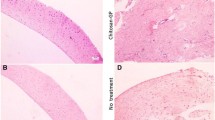Abstract
Biological healing between cartilage and bone is difficult, because their histological structure and physiological function are completely different, and the healing ability of cartilage is limited. A full-thickness articular cartilage defect was created in the femoral groove of ¶48 Japanese white rabbits. The defects were filled with a piece of articular cartilage from the contralateral patella with its superficial zone facing down to the defect. Before grafting, a piece of articular cartilage was treated with 0.05% trypsin or phosphate-buffered saline (PBS) for ¶5 min. The healing process was histologically observed at 2, 4, 8, and 16 weeks after operation. We found that the incorporation process of cartilage implant treated with trypsin was much better than that of PBS-pretreated cartilage. Proliferation and reorganization of chondrocytes in the cartilage implant and subchondral bone ingrowth were observed in the trypsin-pretreated group. Although the observation period in our study was not very long, our results suggest that trypsin pretreatment might be one of the most promising methods to facilitate the repair process between cartilage and bone.
Similar content being viewed by others
Author information
Authors and Affiliations
Additional information
Received: 15 May 1999
Rights and permissions
About this article
Cite this article
Chen, J., Maniwa, S. & Ochi, M. Influence of trypsin on the biological bonding of cartilaginous surface to bone in rabbits. Arch Orth Traum Surg 120, 587–591 (2000). https://doi.org/10.1007/s004020000139
Issue Date:
DOI: https://doi.org/10.1007/s004020000139




